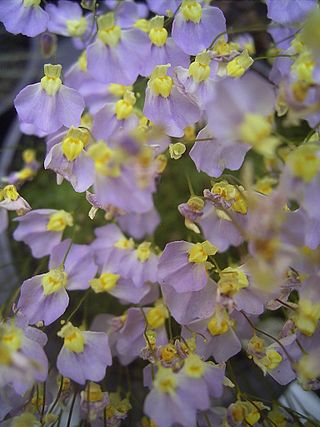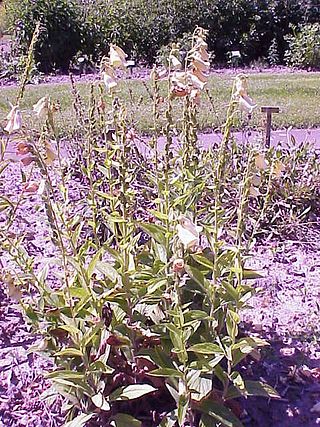
Stapelia is a genus of low-growing, spineless, stem succulent plants, predominantly from South Africa with a few from other parts of Africa. Several Asian and Latin American species were formerly included but they have all now been transferred to other genera. The flowers of certain species, most notably Stapelia gigantea, can reach 41 cm (16 inches) in diameter when fully open. Most Stapelia flowers are visibly hairy and generate the odor of rotten flesh when they bloom.

Monarda is a genus of flowering plants in the mint family, Lamiaceae. The genus is endemic to North America. Common names include bergamot, bee balm, horsemint, and oswego tea, the first being inspired by the fragrance of the leaves, which is reminiscent of bergamot orange. The genus was named for the Spanish botanist Nicolás Monardes, who wrote a book in 1574 describing plants of the New World.

Toona ciliata is a forest tree in the mahogany family which grows throughout South Asia from Afghanistan to Papua New Guinea and Australia.

Isoglossa is a genus of flowering plants in the family Acanthaceae.

Utricularia bisquamata is a small annual carnivorous plant that belongs to the genus Utricularia. It is native to southern Africa, where it can be found in Angola, Lesotho, Madagascar, Namibia, and South Africa. U. bisquamata grows as a terrestrial plant in damp, sandy or peaty soils among mosses by streams or wet depressions at altitudes from near sea level to 1,200 m (3,937 ft) in South Africa and up to 2,250 m (7,382 ft) in Angola. It was originally described and published by Franz Paula von Schrank in 1824.

Spiculaea is a genus of plants defined by a single species, Spiculaea ciliata, commonly known as elbow orchid, and allied to the family Orchidaceae. Endemic to the south-west of Western Australia, the species is unusual in a number of respects; it grows in shallow soil on granite rock outcrops, grows and flowers in the hottest months of the year and has a unique method of using thynnid wasps as pollinators.

The Maputaland-Pondoland-Albany Hotspot (MPA) is a biodiversity hotspot, a biogeographic region with significant levels of biodiversity, in Southern Africa. It is situated near the south-eastern coast of Africa, occupying an area between the Great Escarpment and the Indian Ocean. The area is named after Maputaland, Pondoland and Albany. It stretches from the Albany Centre of Plant Endemism in the Eastern Cape Province of South Africa, through the Pondoland Centre of Plant Endemism and KwaZulu-Natal Province, the eastern side of Eswatini and into southern Mozambique and Mpumalanga. The Maputaland Centre of Plant Endemism is contained in northern KwaZulu-Natal and southern Mozambique.

Isoglossa woodii, commonly known as buckweed, is a monocarpic shrub of the family Acanthaceae, growing up to 4 m tall. It grows in colonies in coastal forest areas of KwaZulu-Natal and marginally into Eastern Cape and Free State of South Africa.

Mimusops caffra is a species of tree in family Sapotaceae. This tree is found in coastal dune vegetation in Southern Africa from the Eastern Cape, through KwaZulu-Natal to southern Mozambique.

Melica ciliata, the hairy melic or silky spike melic, is a species of flowering plant in the grass family Poaceae, native to Europe, north Africa and temperate Asia. It has been introduced to South Australia.

Tetratheca ciliata, commonly known as pink bells, is a small shrub in the family Elaeocarpaceae. It is endemic to southern Australia.

Protogoniomorpha parhassus, the forest mother-of-pearl or common mother-of-pearl, is a species of Nymphalidae butterfly found in forested areas of Africa.

Micromyrtus ciliata is a species of flowering plant in the family Myrtaceae and is endemic to south-eastern continental Australia. It is a spreading to erect shrub with crowded, oblong to egg-shaped leaves and small white or pink flowers arranged singly in upper leaf axils, forming clusters on the ends of branches.

Blephilia ciliata is a species of herbaceous perennial plant in the Lamiaceae (mint) family native to central and eastern North America. It is commonly called downy wood mint. Other common names include downy pagoda-plant, sunny woodmint and Ohio horsemint.

Digitalis ciliata, commonly called hairy foxglove is a member of the genus Digitalis. It has thimble-shaped, yellow to cream colored flowers produced on perennial plants with evergreen foliage. It is native to the Caucasus and is grown as an ornamental in other parts of the world. The species name is derived from the fine hairs that cover the plants stems and flowers.

Pimelea ligustrina is a species of flowering plant in the family Thymelaeaceae, and is endemic to south-eastern Australia. It is a shrub with lance-shaped or narrowly elliptic leaves arranged in opposite pairs, and clusters of creamy-white, white or pinkish flowers usually surrounded by 4 or 8, greenish to reddish brown involucral bracts.

Olearia ciliata, commonly known as the fringed daisy bush, is a small shrub with large clusters of bright purple-blue flowers on a single stem.

Roella is a genus of flowering plants in the family Campanulaceae, native to southern South Africa. They are small shrubs or perennial herbs and can be erect through prostrate in habit.

Chrysocoma ciliata is a shrub that grows to a height of 60 cm. The plant occurs throughout South Africa with the exception of Limpopo and also in Lesotho, Mozambique, and Namibia. In the Western Cape and the Eastern Cape it occurs along with the fynbos on rocky slopes and rocky plains.


















